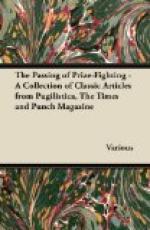* * * * *
What with the scientists who explain things on the assumption that we know nearly as much as they do and those who explain things on the assumption that we know nothing, it is very difficult for you and me to persevere in our original determination to learn something. But I have always felt that Sir RAY LANKESTER is one of the very few who do understand us, and I feel it still more strongly now that I have read his Secrets of Earth and Sea (METHUEN). He is instructive but human; he does not take it for granted that we know what miscegenation means, but he does credit us with a little intelligence. And he realises how many arguments we have had about questions like “Why does the sea look blue?” Personally I rushed at that chapter, though I must say that I was a little disappointed to find that the gist of his answer was “Because water is blue.” You see, if you had a tooth-glass fifteen feet high and filled it with water—But you must find out for yourself. Then I went on to the chapter on Coal, and discovered that “it is fairly certain that the blacker coal which we find in strata of great geological age was so produced by the action of special kinds of bacteria upon peat-like masses of vegetable refuse.” I wonder if Mr. SMILLIE knows that. It might help him to a sense of proportion. The author is constantly setting up a surprising but stimulating relation between the naturalist’s researches and the problems of human life, as when he observes that “the ‘colour bar’ is not merely the invention of human prejudice, but already exists in wild plants and animals,” and in his remarks on mongrels and the regrettable subjection of the males of many species. There are chapters on Wheel Animalcules, Vesuvius, Prehistoric Art—everything—and all are admirably illustrated. A fascinating book.




